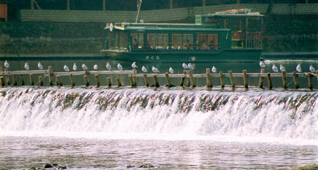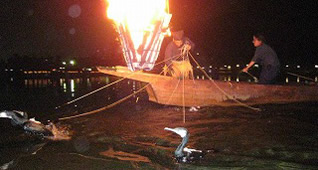
Travel Guide
Introduction
Togetsukyo Bridge, also known as the Moon Crossing Bridge, is a famous picturesque bridge over Oi River in Arashiyama on the western outskirts of Kyoto.
Crossing Togetsukyo Bridge is a highlight of any visit to Arashiyama. From feeding carp fish over the railing to enjoying the splendor of cherry blossoms in the spring and fall foliage, the bridge is a gateway to a simple, stunningly scenic way of life. Another popular way to see the bridge is by a boat ride along the river. It's also enjoyable to go boating in this area.
The area around the bridge is famous for its blossoming cherry trees in spring and brilliant maple trees in autumn. The cherry trees were transplanted here from Yoshino, famed for its cherry blossom, by the same emperor who so lyrically named the bridge. At one time he lived in Tenryuji Temple, only a short stroll away from Togetsukyo Bridge.
Togetsukyo Bridge is located in the center of the river; the upper stream is called Oi River, the lower stream is Kei River. Nobles from Heiankyo enjoyed boat ride and autumn leaves here. Ukai (cormorant fishing), a popular fishing event held every July to mid September.
History
The first bridge at this point, apparently vermillion-colored, was constructed in 836. Located some 200 meters upstream from the current location, it was built to provide easy access to Horinji Temple and therefore called Horinji Bridge. The bridge received its poetic alternative name after Emperor Kameyama (1249-1305) mentioned that the bridge appeared to stretch to the moon.
Over the years, the bridge was repeatedly damaged or destroyed by floods and war, but always rebuilt. The bridge in this image was destroyed by a flood in 1892. At the same location, a concrete bridge was completed in 1934 , which stands to this day.
Oi River
For many hundreds of years until about 1948, the river was used for transportation of people, goods like rice, barley, wheat and charcoal, and timber from as far away as Tamba.
Because the river connected to the Kamo River in Kyoto and Yodo River in Osaka, it afforded unlimited opportunities for fast transportation long before highways and railroads existed. Even construction materials for the massive Osaka Castle and several temples were transported down this river. After its narrow gorges were excavated around 1606, it became Kyoto’s main artery of commerce.
 |
 |
| View of the river | Ukai (cormorant fishing) |
Travel Advice
Sightseeting
Unique Rickshaw tour and boat tour are provided. Tickets are required. Visitors can enjoy Arashiyama on the excellent guide by the staff while riding the rickshaw. There are many boat tours for visitors to choose, and special tour for Ukai watching is arranged from July 1 to mid September.
Ukai (cormorant fishing)
Cormorant fishing is a traditional fishing method in which fishermen use trained cormorants to fish in rivers.
| Events in 2019 | ||
| Kyoto Arashiyama Hanatouro | Streets, bamboo forest, Togetsukyo Bridge and temples will be illuminated. There will also be traditional Japanese flower arrangement displayed in the streets and different programs every day including music performances and stamp rally. | Dec 13(Fri) to 22(Sun) |
Visit
| Address | Tenryuji-susukinobaba-cho, Ukyo-ku, Kyoto-shi, Kyoto | |
| Phone | 075-861-0012 (Arashiyama Hoshokai) | |
| Admission | Free | |
| Hours | Free time | |
| Closed | Open 7 Days a Week | |
| Duration | 10 minutes | |
| Getting There | By Train 1 minute walk from Arashiyama Station on Keifuku Electric Railway Arashiyama Honsen. By Car Take Meishin Expressway to the Kyoto-minami exit. It is approximately 40 minutes from exit. |
|
| Parking | No parking available | |

